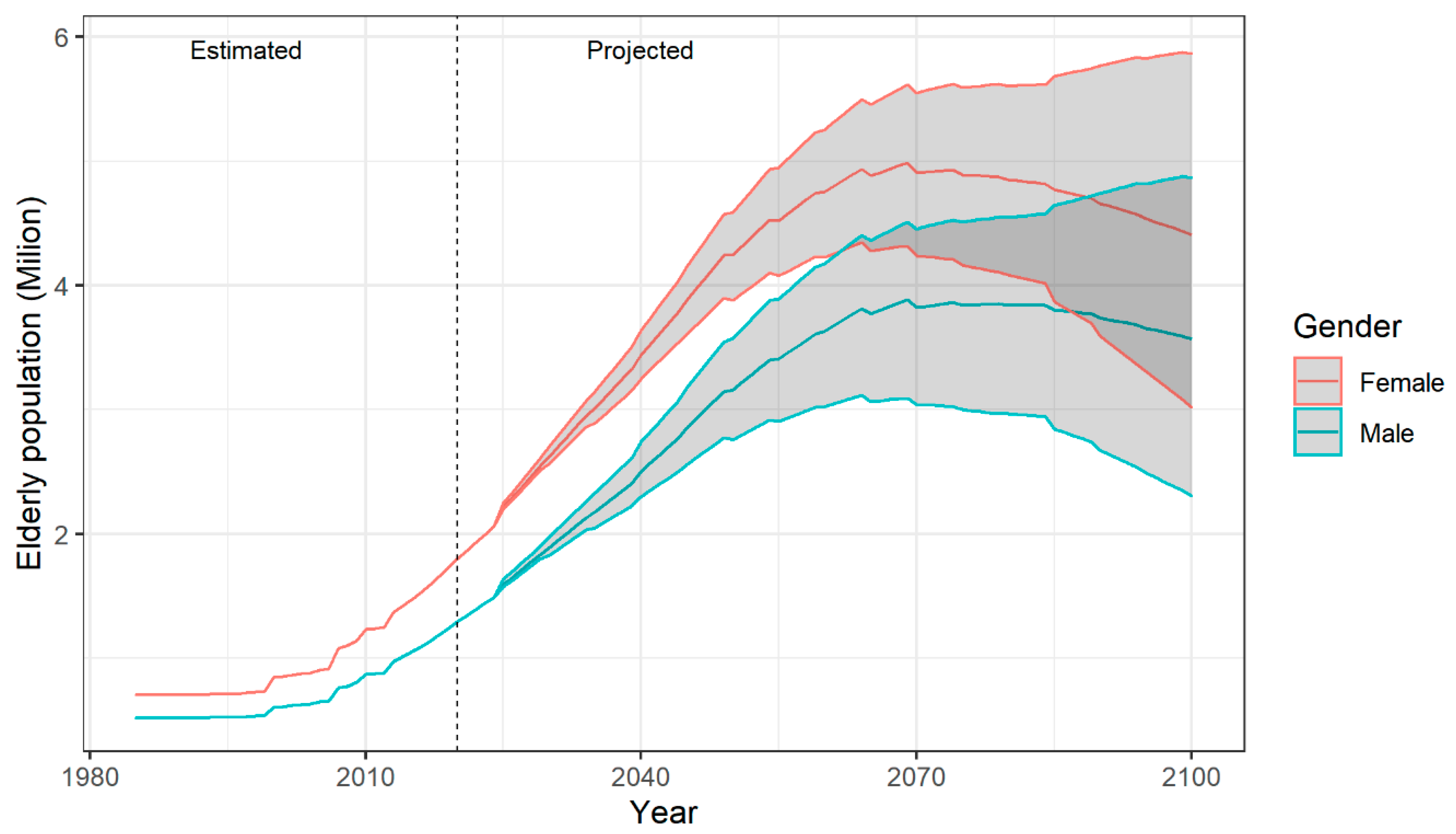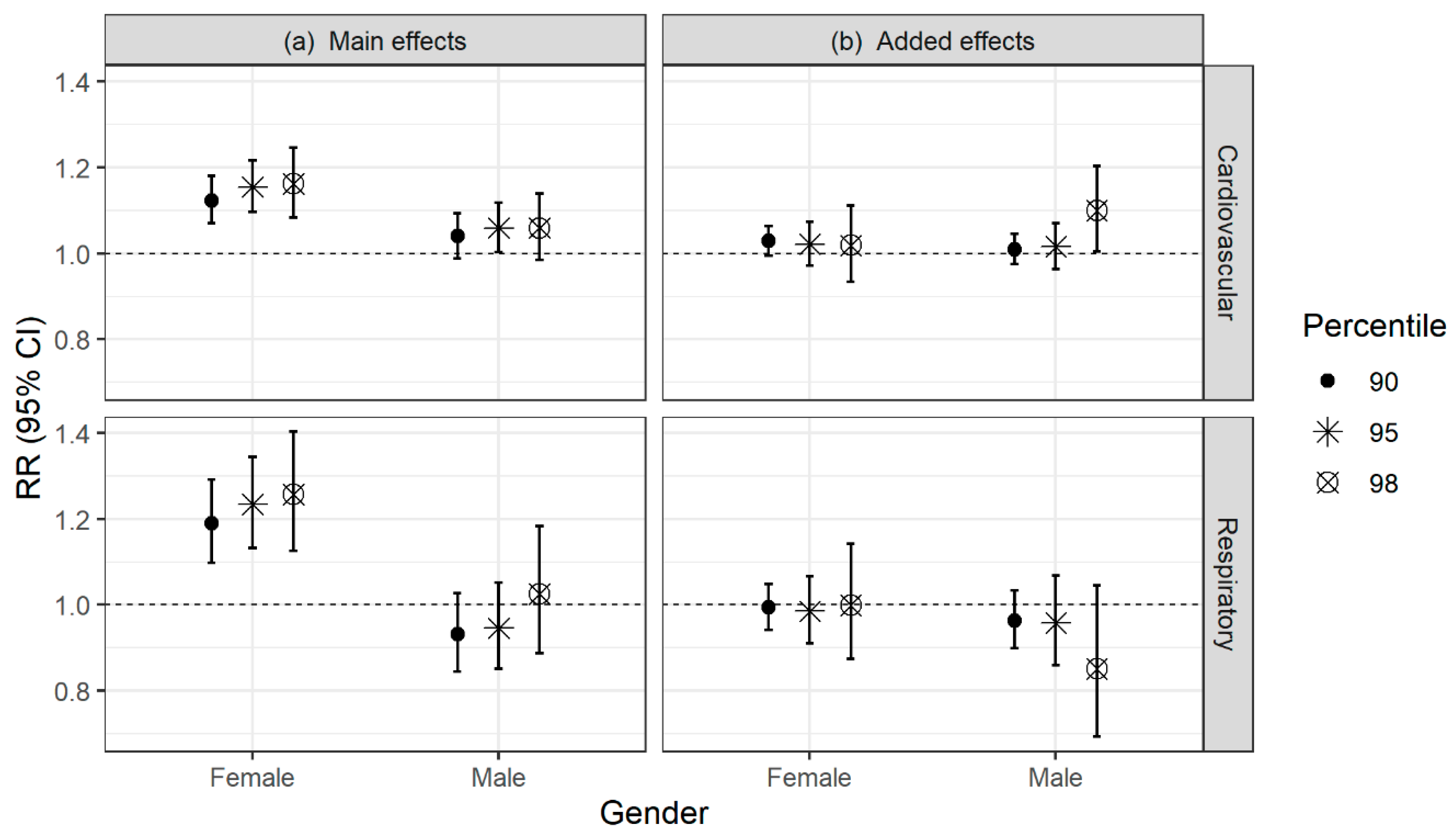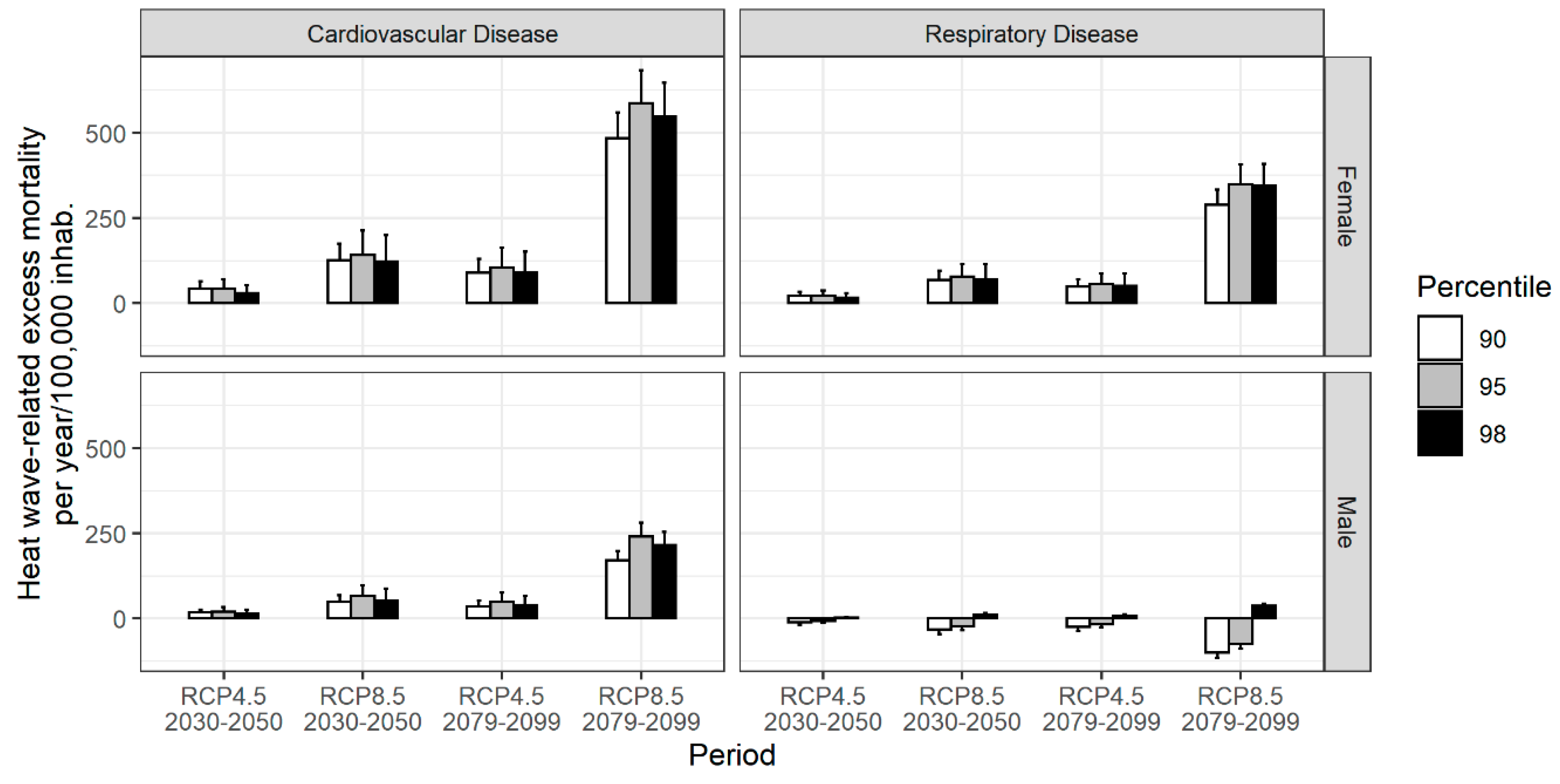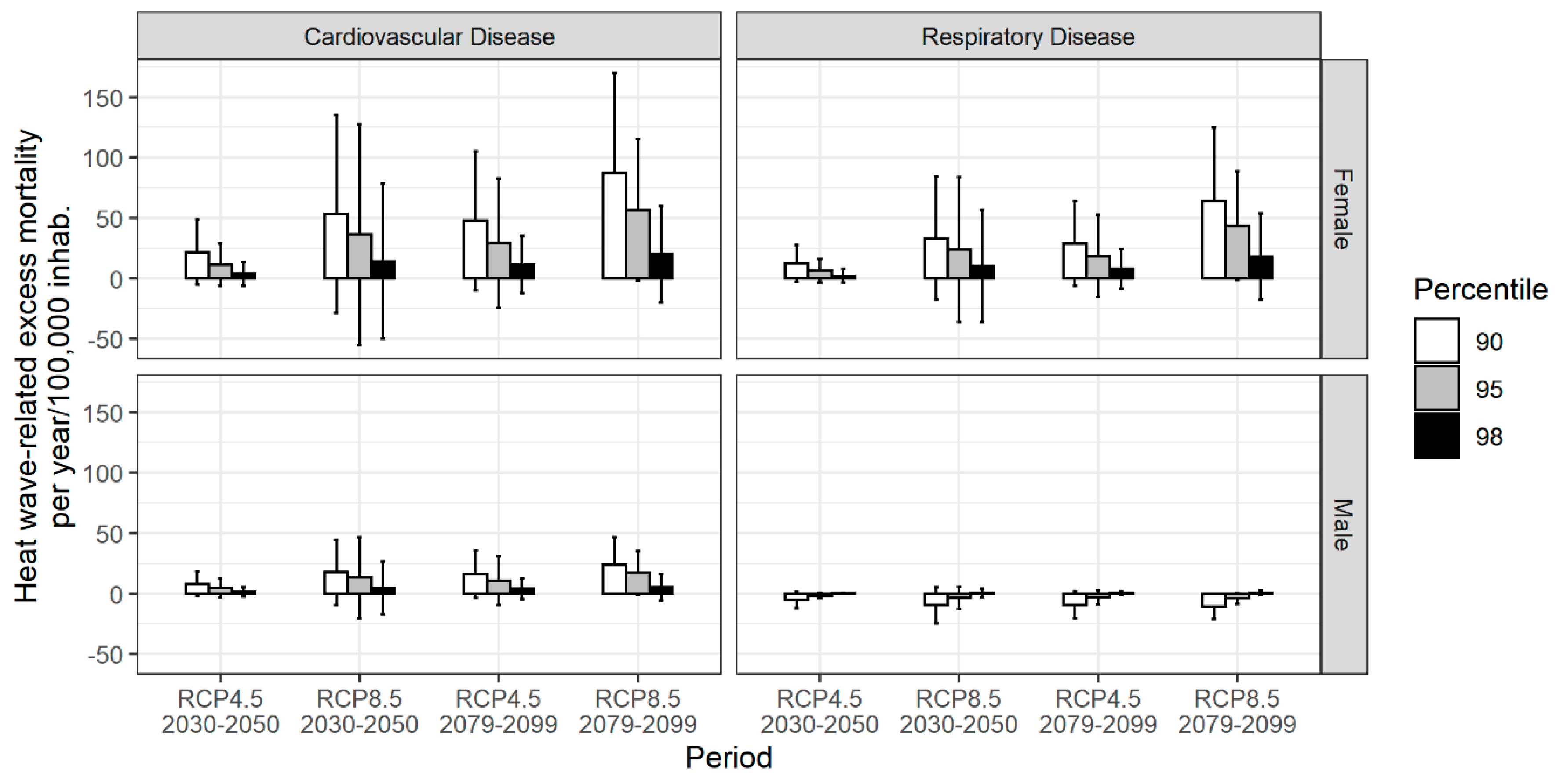Heat Wave and Elderly Mortality: Historical Analysis and Future Projection for Metropolitan Region of São Paulo, Brazil
Abstract
:1. Introduction
2. Experiments
2.1. Metropolitan Region of São Paulo (MRSP)
2.2. Data
2.2.1. Mortality and Elderly Population of the MRSP
2.2.2. Historical Temperature and Future Simulations
2.3. Statistical Analysis
2.3.1. Identification of Heat Waves
- (1)
- non-adaptation: using current heat wave daily threshold (1985–2005), as presented in Equation (1), and:
- (2)
- hypothetical adaptation: heat wave daily threshold is recalculated with Equation (1) using the future 90th, 95th and 98th percentiles of maximum daily temperature during the period of 2030 to 2050 (the new climatological reference for the near future) and during the period of 2079 to 2099 (new climatological reference for the distant future). Those new references are used as indication of a complete adaptation, through six levels of adaptation, described in Section 1.
2.3.2. Projection of the Elderly Population of the MRSP
2.3.3. Historical Heat-Wave Elderly Mortality Relationships
2.3.4. Projection of Heat Wave-Related Annual Excess of Elderly Mortality
2.3.5. Software
3. Results
4. Discussion
5. Conclusions
Supplementary Materials
Author Contributions
Funding
Acknowledgments
Conflicts of Interest
References
- Leite, J.C. Do mistério das eras do gelo às mudanças climáticas abruptas. Sci. Zudia 2015, 13, 811–839. [Google Scholar] [CrossRef] [Green Version]
- Oliveira, M.J.; Batista, G.M.M.; Carneiro, C.D.R.; Vecchia, F.A.Z. História geológica e Ciência do clima: Métodos e origens do estudo dos ciclos climáticos na Terra. Terræ 2015, 12, 3–26. [Google Scholar]
- IPCC. Climate Change 2014: Synthesis Report. In Contribution of Working Groups I, II and III to the Fifth Assessment Report of the Intergovernmental Panel on Climate Change; IPCC: Geneva, Switzerland, 2014; p. 151. [Google Scholar]
- Santos, J.O.; Santos, R.M.S.; Fernandes, A.A.; Souso, J.S.; Borges, M.G.B.; Ferreira, R.T.F.; Salgado, A.B. Os impactos produzidos pelas mudanças climáticas. ACSA 2013, 9, 9–16. [Google Scholar] [CrossRef]
- Robinson, P.J. On the Definition of a Heat Wave. J. Appl. Meteor. 2001, 40, 762–775. [Google Scholar] [CrossRef]
- Gasparrini, A.; Armstrong, B. The impact of heat waves on mortality. Epidemiology 2011, 22, 68–73. [Google Scholar] [CrossRef] [PubMed] [Green Version]
- Russo, S.; Dosio, A.; Graversen, R.G.; Sillmann, J.; Carrao, H.; Dunbar, M.B.; Singleton, A.; Montagna, P.; Barbola, P.; Vogt, J.V. Magnitude of extreme heat waves in present climate and their projection in a warming world. J. Geophys. Res. Atmos. 2014, 119, 12500–12512. [Google Scholar] [CrossRef] [Green Version]
- Astrõm, D.O.; Forsberg, B.; Rocklõv, J. Heat wave impact on morbidity and mortality in the elderly population: A review of recent studies. Maturitas 2011, 69, 99–105. [Google Scholar] [CrossRef]
- Guergova, S.; Dufour, A. Thermal sensitivity in the elderly: A review. Ageing Res. Rev. 2011, 10, 80–92. [Google Scholar] [CrossRef]
- WHO. World Health Organization. Available online: http://www.who.int/eportuguese/countries/bra/pt (accessed on 11 January 2020).
- Guo, Y.; Gasparrini, A.; Armstrong, B.G.; Tawatsupa, B.; Tobias, A.; Lavgne, E.; Coelho, M.S.Z.S.; Pan, X.; Kim, H.; Hashizume, M.; et al. Heat wave and mortality: A multicountry, multicommunity study. Environ. Health Perspect. 2017, 125, 1–11. [Google Scholar] [CrossRef] [Green Version]
- Guo, Y.; Gasparrini, A.; Li, S.; Sera, F.; Vicedo-Cabrera, A.M.; Coelho, M.S.Z.S.; Saldiva, P.H.N.; Lavigne, E.; Tawatsupa, B.; Punnasiri, K.; et al. Quantifying excess deaths related to heat waves under climate change scenarios: A multicountry time series modelling study. PLoS Med. 2018, 15, 1–17. [Google Scholar] [CrossRef]
- Steen, Y.V.; Ntarladima, A.; Grobbee, R.; Karsenberg, D.; Vaartjes, I. Sex differences in mortality after heat waves: Are elderly women at higher risk? Int. Arch. Occup. Env. Health 2019, 92, 37–48. [Google Scholar] [CrossRef] [PubMed]
- Nori-Sarma, A.; Anderson, G.B.; Rajiva, A.; Azhar, G.S.; Gupta, P.; Pednekar, M.S.; Son, Y.; Peng, R.D.; Bell, M.L. The impact of heat waves on mortality in Northwest India. Environ. Res. 2019, 176, 108546. [Google Scholar] [CrossRef] [PubMed]
- Royé, D.; Codesido, R.; Tobías, A.; Taracido, M. Heat wave intensity and daily mortality in four of the largest cities of Spain. Environ. Res. 2020, 182, 109027. [Google Scholar] [CrossRef] [PubMed]
- Lopes, R.J.; Fioravanti, C. Ondas de Calor: Mais Intensas, Longas e Frequentes. Available online: https://revistapesquisa.fapesp.br/ondas-de-calor-mais-intensas-longas-e-frequentes/ (accessed on 20 January 2019).
- Geirinhas, J.L.; Trigo, R.M.; Libonati, R.; Coelho, C.A.S.; Palmeira, A.C. Climatic and synoptic characterization of heat waves in Brazil. Int. J. Climatol. 2017, 38. [Google Scholar] [CrossRef]
- Guo, Y.; Barnett, A.G.; Tong, S. High temperatures-related elderly mortality varied greatly from year to year: Important information for heat-warning systems. Sci. Rep. 2012, 2, 830. [Google Scholar] [CrossRef] [Green Version]
- Pereira, R.H.M.; Carvalho, H.R.C.; Souza, P.H.G.F.; Camarano, A.A. Envelhecimento populacional, gratuidades no transporte público e seus efeitos sobre as tarifas na Região Metropolitana de São Paulo. Rev. Bras. Estud. Popul. 2015, 32, 101–120. [Google Scholar] [CrossRef] [Green Version]
- Wight, D.; Wimbush, E.; Jepson, R.; Doi, L. Six steps in quality intervention development (6SQuID). J. Epidemiol. Community Health 2016, 70, 520–525. [Google Scholar] [CrossRef] [Green Version]
- IBGE. Brazilian Institute of Geography and Statistics. Available online: www.ibge.gov.br (accessed on 20 January 2019).
- Kottek, M.; Grieser, J.; Beck, C.; Rudolf, B.; Rubel, F. World Map of the Köppen-Geiger Climate Classification Updated. Meteorol. Z. 2006, 15, 259–263. [Google Scholar] [CrossRef]
- Pell, M.; Finlayson, B.; Mcmahon, T. Updated World Map of the Köppen-Geiger Climate Classification. Hydrol. Earth Syst. Sci. Discuss. 2007, 11, 1633–1644. [Google Scholar] [CrossRef] [Green Version]
- DATASUS. Department of Informatics of the Brazilian Unified Health System. Available online: www.datasus.gov.br (accessed on 14 July 2019).
- Law nº 10741/2003: Brazilian Elderly Status. Available online: http://www.planalto.gov.br/ccivil_03/leis/2003/L10.741.htm (accessed on 10 January 2020).
- Meteorological Station of Institute of Astronomy, Geophysics and Atmospheric Sciences. University of São Paulo, Brazil. Available online: http://www.estacao.iag.usp.br (accessed on 5 June 2019).
- Projections of Climate Change for South America Regionalized by the Eta Model (PROJETA). Available online: https://projeta.cptec.inpe.br/ (accessed on 5 May 2019).
- Chou, S.C.; Lyra, A.; Mourão, C.; Dereczynski, C.; Pilotto, I.; Gomes, J.; Bustamante, J.; Tavares, P.; Silva, A.; Rodrigues, D.; et al. Evaluation of the Eta Simulations Nested in Three Global Climate Models. Am. J. Clim. Chang. 2014, 3, 438–454. [Google Scholar] [CrossRef] [Green Version]
- Lyra, A.; Tavares, P.; Chou, S.C.; Sueiro, G.; Dereczynski, C.P.; Sondermann, M.; Silva, A.; Marengo, J.; Giarolla, A. Climate change projections over three metropolitan regions in Southeast Brazil using the non-hydrostatic Eta regional climate model at 5-km resolution. Appl. Clim. 2018, 132, 663–682. [Google Scholar] [CrossRef]
- Zhang, L.; Zhang, Z.; Ye, T.; Zhou, M.; Wang, C.; Yin, P.; Hou, B. Mortality effects of heat waves vary by age and area: A multi-area study in China. Environ. Health 2018, 17, 54. [Google Scholar] [CrossRef] [PubMed] [Green Version]
- Siegel, J.S.; Swanson, D.A. The Methods and Materials of Demography, 2nd ed.; Elsevier Academic Press: San Diego, CA, USA, 2004; p. 835. [Google Scholar]
- United Nations World Population Prospects 2019. Available online: https://population.un.org/ (accessed on 14 April 2020).
- Curriero, F.C.; Heiner, K.S.; Samet, J.M.; Zeger, S.L.; Strug, L.; Patz, J.A. Temperature and mortality in 11 cities of the eastern United States. Am. J. Epidemiol. 2002, 155, 80–87. [Google Scholar] [CrossRef] [PubMed]
- Peng, R.D.; Bobb, J.F.; Tebaldi, C.; McDaniel, L.; Bell, M.L.; Dominici, F. Toward a quantitative estimate of future heat wave mortality under global climate change. Environ. Health Perspect. 2011, 119, 701–706. [Google Scholar] [CrossRef] [Green Version]
- R Development Core Team. R: A Language and Environment for Statistical Computing; R Foundation for Statistical Computing: Vienna, Austria, 2010. [Google Scholar]
- Campbell, S.; Remenyi, T.A.; White, C.J.; Johnston, F.H. Heatwave and health impact research: A global review. Health Place 2018, 53, 210–218. [Google Scholar] [CrossRef]
- Song, X.; Wang, S.; Li, T.; Tian, J.; Ding, G.; Wang, J.; Wang, J.; Shang, K. The impact of heat waves and cold spells on respiratory emergency department visits in Beijing, China. Sci. Total Environ. 2018, 1499–1505. [Google Scholar] [CrossRef]
- Kenney, W.L.; Craighead, D.H.; Alexander, L.M. Heat waves, aging, and human cardiovascular health. Med. Sci. Sports Exerc. 2014, 46, 1891–1899. [Google Scholar] [CrossRef] [Green Version]
- Peng, Y.; Renjie, C.; Lijun, W.; Cong, L.; Yue, N.; Weidong, W.; Yixuan, J.; Yunning, L.; Jiangmei, L.; Jinlei, Q.; et al. The added effects of heatwaves on cause-specific mortality: A Nationwide analysis in 272 Chinese cities. Environ. Int. 2018, 121, 898–905. [Google Scholar] [CrossRef]
- Kenney, W.L. A review of comparative responses of men and women to heat stress. Environ. Res. 1985, 37, 1–11. [Google Scholar] [CrossRef]
- Rosano, G.; Vitale, C.; Marazzi, G.; Volterrani, M. Menopause and cardiovascular disease: The evidence. Climacteric 2007, 10, 19–24. [Google Scholar] [CrossRef]
- Kondo, N.; Taylor, N.A.; Shibasaki, M.; Aoki, K.; Muhamed, A.M.C. Thermoregulatory Adaptation in Humans and Its Modifying Factors. Glob. Environ. Res. 2009, 13, 35–41. [Google Scholar]
- Kharin, V.V.; Zwiers, F.W.; Zhang, X.; Wehner, M. Changes in temperature and precipitation extremes in the CMIP5 ensemble. Clim. Chang. 2013, 119, 345–357. [Google Scholar] [CrossRef]
- Gasparrini, A.; Guo, Y.; Sera, F.; Vicedo-Cabrera, A.M.; Huber, V.; Tong, S.; Coelho, M.D.S.Z.S.; Saldiva, P.H.N.; Lavigne, E.; Correa, P.M.; et al. Projections of temperature-related excess mortality under climate change scenarios. Lancet Planet Health 2017, 1, e360–e367. [Google Scholar] [CrossRef]





| Case Historical | Period | Scenario | HW (days) | Duration (Days) | Intensity (°C) | ||||||
|---|---|---|---|---|---|---|---|---|---|---|---|
| 90th | 95th | 98th | 90th | 95th | 98th | 90th | 95th | 98th | |||
| 1985–2005 | Model | 13 ± 12 | 4 ± 7 | 2 ± 3 | 6 ± 3 | 5 ± 2 | 4 ± 1 | 32.1 ± 1.4 | 32.5 ± 1.2 | 32.9 ± 1.2 | |
| Non-adaptation | 2030–2050 | RCP4.5 | 63 ± 32 | 48 ± 30 | 35 ± 28 | 7 ± 6 | 6 ± 6 | 6 ± 5 | 33.6 ± 1.8 | 34.2 ± 1.6 | 34.6 ± 1.5 |
| RCP8.5 | 93 ± 44 | 76 ± 43 | 60 ± 42 | 8 ± 9 | 7 ± 8 | 7 ± 6 | 34.4 ± 2.5 | 34.9 ± 2.3 | 35.5 ± 2.1 | ||
| 2079–2099 | RCP4.5 | 109 ± 42 | 92 ± 46 | 77 ± 49 | 10 ± 12 | 6 ± 6 | 6 ± 5 | 34.8 ± 2.5 | 35.3 ± 2.3 | 35.7 ± 2.2 | |
| RCP8.5 | 174 ± 27 | 165 ± 28 | 156 ± 29 | 20 ± 25 | 10 ± 17 | 14 ± 19 | 37.1 ± 3.4 | 37.4 ± 3.2 | 37.7 ± 3.1 | ||
| Adaptation | 2030–2050 | RCP4.5 | 13 ± 16 | 4 ± 7 | 1 ± 4 | 6 ± 4 | 5 ± 4 | 4 ± 3 | 35.4 ± 1.8 | 36.5 ± 1.3 | 36.7 ± 1.1 |
| RCP8.5 | 14 ± 17 | 5 ± 10 | 2 ± 4 | 6 ± 4 | 6 ± 3 | 4 ± 2 | 37.7 ± 2.0 | 38.9 ± 1.4 | 39.5 ± 1.3 | ||
| 2079–2099 | RCP4.5 | 14 ± 21 | 6 ± 14 | 2 ± 10 | 6 ± 5 | 5 ± 2 | 5 ± 2 | 38.4 ± 1.9 | 39.5 ± 1.8 | 40.1 ± 1.8 | |
| RCP8.5 | 10 ± 10 | 5 ± 5 | 1 ± 3 | 5 ± 2 | 4 ± 2 | 4 ± 2 | 42.0 ± 42.1 | 43.0 ± 1.7 | 43.9 ± 1.6 | ||
© 2020 by the authors. Licensee MDPI, Basel, Switzerland. This article is an open access article distributed under the terms and conditions of the Creative Commons Attribution (CC BY) license (http://creativecommons.org/licenses/by/4.0/).
Share and Cite
Diniz, F.R.; Gonçalves, F.L.T.; Sheridan, S. Heat Wave and Elderly Mortality: Historical Analysis and Future Projection for Metropolitan Region of São Paulo, Brazil. Atmosphere 2020, 11, 933. https://doi.org/10.3390/atmos11090933
Diniz FR, Gonçalves FLT, Sheridan S. Heat Wave and Elderly Mortality: Historical Analysis and Future Projection for Metropolitan Region of São Paulo, Brazil. Atmosphere. 2020; 11(9):933. https://doi.org/10.3390/atmos11090933
Chicago/Turabian StyleDiniz, Fernanda Rodrigues, Fábio Luiz Teixeira Gonçalves, and Scott Sheridan. 2020. "Heat Wave and Elderly Mortality: Historical Analysis and Future Projection for Metropolitan Region of São Paulo, Brazil" Atmosphere 11, no. 9: 933. https://doi.org/10.3390/atmos11090933
APA StyleDiniz, F. R., Gonçalves, F. L. T., & Sheridan, S. (2020). Heat Wave and Elderly Mortality: Historical Analysis and Future Projection for Metropolitan Region of São Paulo, Brazil. Atmosphere, 11(9), 933. https://doi.org/10.3390/atmos11090933






